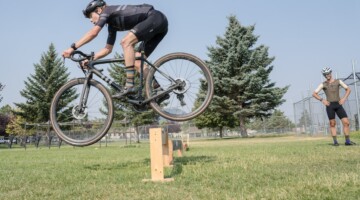Adventure is out there! Are you ready?
We’re often asked about what bike is best for events like the Dirty Kanza, the Lost and Found and the Crusher in the Tushar. But we also get questions about what to carry on rides like these.
For example, we recently heard from Joseph C. that he is:
…heading to Utah for my first ever Crusher in the Tushar. I don’t have delusions of winning the event, and I want to pack what I may need given the remote nature of the route. Do you have ideas on what I should take? I’m planning to ride my cyclocross bike, a Trek Crockett, that’s currently set up with SRAM 1x and has canti brakes. I’ll run my Bontrager Aeuolus 3 wheels as well, set up tubeless, with likely a file tread or similar style tire. Thanks!

The Crusher races through the remote wilderness of the Tushar Mountains and the Fishlake National Forest, so being prepared is key. Photo: Christopher See.
If you’re one of the growing number of racers and riders heading to some of the bigger gravel events like this, you know that equipment choices can make or break your experience. We’d start by pointing Joseph towards our post on going lower gearing for gravel races, given the fact he’s currently using a 1x setup, presumably for cyclocross. The Crusher has it’s fair share of climbing, and even an 11-32 tooth cassette may not be enough depending on Joseph’s front ring.
But there’s also the question of what he needs to carry on his ride to make it to the finish should an untimely mechanical happen.
There are, of course, the basics, aside from the bike itself, that a rider would take on any ride. Those items include:
- kit, helmet, sunglasses, shoes and gloves
- preferred nutrition and hydration
- sunscreen and chamois cream
But then you get into the particulars of gear for the bike and course. A simple puncture kit may not be enough. So since we too wouldn’t be looking to set any land speed records at an event like the Crusher, we’d carry the following:
- a tire plug and spare sealant, as we’d prefer to run tubeless given the choice
- a tire boot, in the event of a severe cut
- two tubes
- a frame or mini pump
- a patch kit
- tire levers
- a multitool with a chaintool or a separate chaintool and perhaps a spare link or two
- a small bottle of chain lube

File photo of the Ritchey CPR 12+ multitool. Just one of the items riders need to have handy on longer, more remote rides. Sea Otter Classic 2016. © Cyclocross Magazine
That should, hopefully, be enough to take Joseph to the finish line even if he suffers a puncture or other fairly typical mechanical. If he was running disc brakes, given the nature of gravel race courses in general, we’d also recommend throwing a spare set of brake pads in his saddle bag or Camelbak, especially if he’s not done any pre-event brake maintenance.
There are also those of us out there that are quite resourceful and many riders are also mechanics, and for those folks there may be a few other things worth throwing in there, including:
- a spare spoke or two, in the most common length(s) for your wheels
- a derailleur cable, and if running cable activated brakes, a spare brake cable
- some duct tape rolled up on itself (not the entire roll)
Why duct tape? Have you ever seen someone’s cleat/pedal interface fail? Taping a rider’s foot to the pedal can serve as a toe strap in an emergency. Plus, duct tape can fix nearly anything else like a torn tire, damaged shoe or torn bar tape that’s coming unraveled.
Yes, this list is over the top. But like we said, we’re looking to cover almost any possibility and to try and ensure a ride finish, not win the race. A few extra ounces in a saddle bag is a small price to pay to make sure you make it to the ride’s finish rather than ride the broom wagon home because of an untimely mechanical.
Have a Wednesday Wondering of your own? Fill out our form here and we’ll try to answer your question online or in a future print issue of Cyclocross Magazine.



























